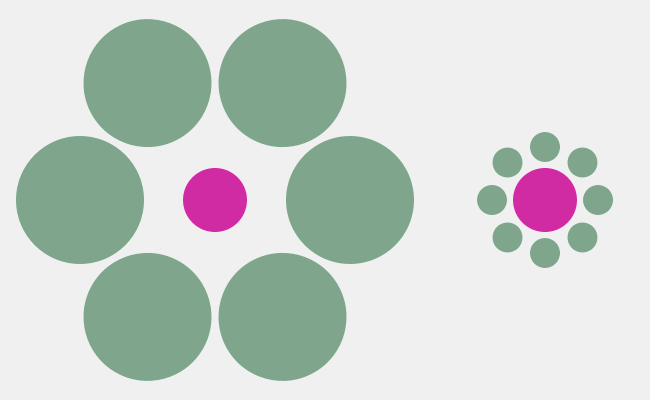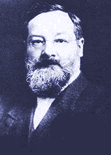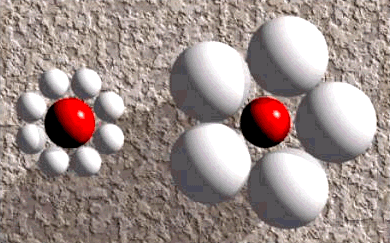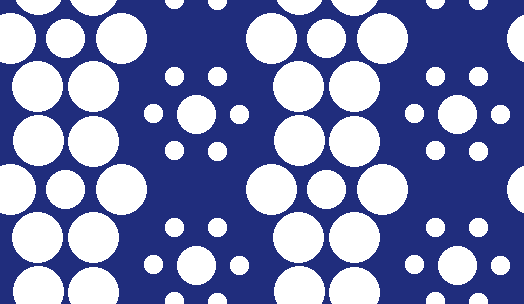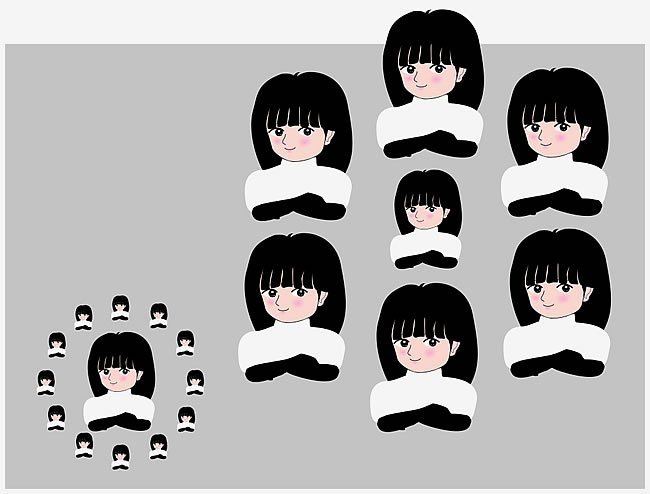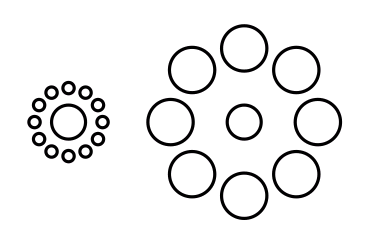| |
|
| Ebbinghaus–Titchener
illusion |
| |
The
Ebbinghaus illusion (sometimes called the "Titchener
illusion") is an optical illusion of relative size
perception. In the best-known version of the illusion,
two circles of identical size are placed near to each
other and one is surrounded by large circles while the
other is surrounded by small circles; the first central
circle then appears smaller than the second central circle.
The Ebbinghaus illusion, as well as numerous other visual
and perceptual illusions, provide a valuable way to investigate
how the eye and brain process visual information. Equally,
they are used by artists for visual effect, entertaining
and satisfying the endless fascination human beings have
with novelty and creativity.
|
|
|
|
| |
|
Description
The classic Ebbinghaus illusion
consists of a circle surrounded in one image by smaller circles,
and in another by larger circles. The viewer tends to perceive
the circle surrounded by smaller circles as being larger than
the circle in the other image, even though both are exactly the
same size.
Explanation
The difference in size perception
is due to the surrounding visual cues (larger or smaller surrounding
circles), and the way the brain processes these visual cues. The
Ebbinghaus illusion has played a crucial role in the debate over
the existence of separate pathways in the brain for perception
and action. Experiments have shown that, while adult subjects
perceive the center circles as differing in size, they reach out
to grasp the circle accurately. In theory, this is due to the
process of perception using a different visual pathway than the
process of action. While adults rarely misjudge the size of the
center disk while reaching for it, experiments have found that
young children do, in fact, misjudge size both perceptually and
through action. Researchers have proposed that this is because
young children rely on both pathways to process tasks, instead
of the separate pathways that adults use.
|
|
|
|
|
| |
|
| |
|
Hermann
Ebbinghaus (January 24, 1850 — February 26, 1909), German
psychologist
Hermann
Ebbinghaus was the founder of experimental psychology of memory.
Among his most famous discoveries are the forgetting curve, the
learning curve and the spacing effect. Ebbinghaus published his
groundbreaking results in a monograph entitled “Uber das Gedachtnis”
(1885), which was later translated into English as “Memory:
A Contribution to Experimental Psychology” (1913).
|
|
|
|
Edward
Bradford Titchener (11 January 1867 – 3 August 1927), British
psychologist
Edward
Bradford Titchener was a psychologist who studied under Wilhelm
Wundt for several years. Titchener is best known for creating his
version of psychology that described the structure of the mind:
structuralism. He created the largest doctoral program in the United
States (at the time) after becoming a professor at Cornell University,
and his first graduate student, Margaret Floy Washburn, became the
first woman to be granted a PhD in psychology (1894). |
|
|
|
| |
| |
| |
| |
| |
|
| |
|
Visual Phenomena |
| |
REFERENCES:
•
V.
H. Franz, F. Scharnowski and K. R. Gegenfurtner (2005). "Illusion
effects on grasping are temporally constant not dynamic".
• J Exp Psychol Hum Percept Perform
31 (6): 1359–1378.
•
M.
A. Goodale & Brenda Milner (January 1992). "Separate pathways
for perception and action". Trends in Neuroscience 15 (1): 20–25.
• Burton,
Gregory. "The Tenacity of Historical Misinformation: Titchener
Did Not Invent the Titchener Illusion" The History of Psychology.
American Psychological Association. 2007.
• Hanisch,
C., J. Konszak, and C. Dohle. "The effect of the Ebbinghaus illusion
on grasping behaviour of children" Department of Psychology.
University of Dusseldorf, Germany. 2007 |
|
| |
|
| |
|
| |
|
|
| |
|
Copyright
© 2004 ABC-people.com
Design and conception BeStudio © 2023 |
|
|
|
